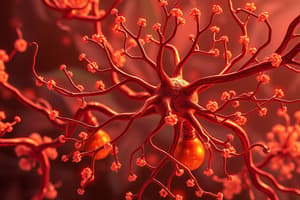Podcast
Questions and Answers
Which type of receptor is responsible for the slowing of heart rate?
Which type of receptor is responsible for the slowing of heart rate?
- Alpha adrenoreceptor
- Nicotinic receptor
- Muscarinic M2 receptor (correct)
- Metabotropic M3 receptor
What is the effect of activating the metabotropic M3 receptor?
What is the effect of activating the metabotropic M3 receptor?
- Contraction of smooth muscle (correct)
- Inhibition of calcium channels
- Increase in heart rate
- Reduction in cyclic AMP levels
Which receptor subtype is involved in the release of adrenaline and noradrenaline from the adrenal medulla?
Which receptor subtype is involved in the release of adrenaline and noradrenaline from the adrenal medulla?
- Nicotinic receptor (correct)
- Muscarinic M2 receptor
- Metabotropic M3 receptor
- Alpha adrenoreceptor
What is the function of the nicotinic receptor at the neuromuscular junction?
What is the function of the nicotinic receptor at the neuromuscular junction?
Which G-protein coupled receptor (GPCR) subtype is involved in promoting the influx of calcium to increase heart rate?
Which G-protein coupled receptor (GPCR) subtype is involved in promoting the influx of calcium to increase heart rate?
In which location are muscarinic receptors found?
In which location are muscarinic receptors found?
What is the role of the alpha q type G-protein coupled receptor (GPCR) when activated?
What is the role of the alpha q type G-protein coupled receptor (GPCR) when activated?
What is the general composition of all nicotinic receptors?
What is the general composition of all nicotinic receptors?
Which of the following is a subtype of muscarinic receptor responsible for salivary and gastric acid secretion?
Which of the following is a subtype of muscarinic receptor responsible for salivary and gastric acid secretion?
What is the effect of activating the metabotropic M2 receptor?
What is the effect of activating the metabotropic M2 receptor?
What is the role of the alpha q type G-protein coupled receptor (GPCR) when activated?
What is the role of the alpha q type G-protein coupled receptor (GPCR) when activated?
Which G-protein coupled receptor (GPCR) subtype is involved in promoting the influx of calcium to increase heart rate?
Which G-protein coupled receptor (GPCR) subtype is involved in promoting the influx of calcium to increase heart rate?
What is the general composition of all nicotinic receptors?
What is the general composition of all nicotinic receptors?
Which subtype of muscarinic receptor is responsible for smooth muscle contraction in the gastrointestinal and respiratory tract?
Which subtype of muscarinic receptor is responsible for smooth muscle contraction in the gastrointestinal and respiratory tract?
What is the effect of activating the metabotropic M3 receptor?
What is the effect of activating the metabotropic M3 receptor?
Flashcards are hidden until you start studying
Study Notes
Receptors and Their Functions
- Muscarinic receptors are responsible for slowing down heart rate.
- Activating the metabotropic M3 receptor increases smooth muscle contraction, particularly in the gastrointestinal and respiratory tract.
- The M1 receptor subtype is involved in the release of adrenaline and noradrenaline from the adrenal medulla.
- The nicotinic receptor at the neuromuscular junction is responsible for muscle contraction.
- The alpha 1 receptor subtype, a G-protein coupled receptor (GPCR), promotes the influx of calcium to increase heart rate.
- Muscarinic receptors are found in the brain, autonomic ganglia, and peripheral tissues.
- Activating the alpha q type G-protein coupled receptor (GPCR) increases phospholipase C activity.
- All nicotinic receptors are composed of five subunits.
- The M1 subtype of muscarinic receptor is responsible for salivary and gastric acid secretion.
- Activating the metabotropic M2 receptor slows down heart rate.
- The M3 subtype of muscarinic receptor is responsible for smooth muscle contraction in the gastrointestinal and respiratory tract.
- Activating the metabotropic M3 receptor increases smooth muscle contraction, particularly in the gastrointestinal and respiratory tract.
Studying That Suits You
Use AI to generate personalized quizzes and flashcards to suit your learning preferences.




